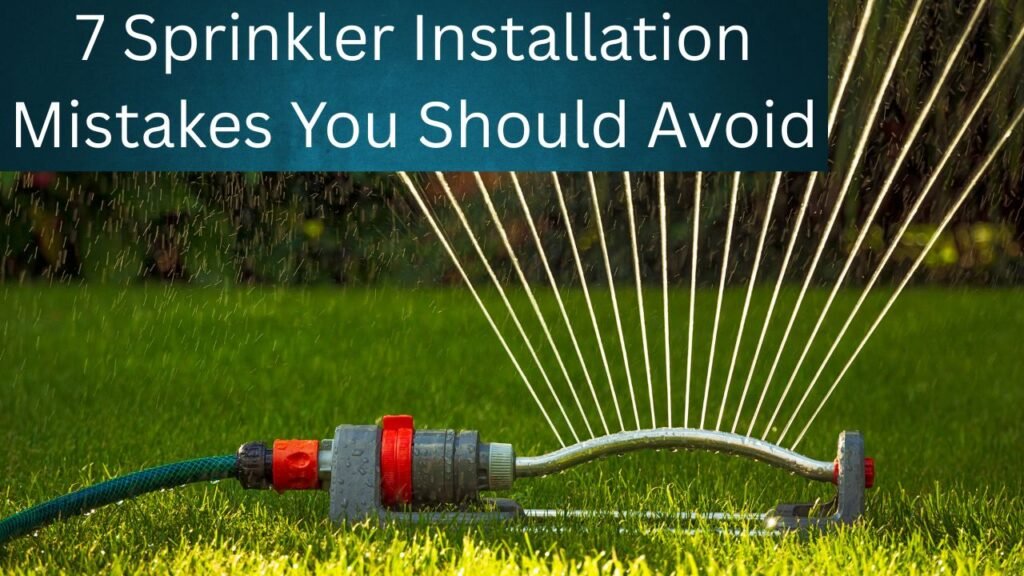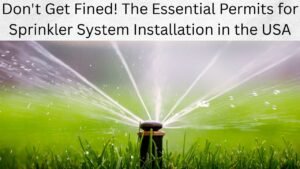Sprinkler systems make life easier — until they don’t. A lot of homeowners in the U.S. jump into installing sprinklers thinking it’s just digging a few trenches and plugging in parts. But if you’ve ever wondered why is my lawn patchy even with a sprinkler system?, or why is my water bill suddenly through the roof?, you might be dealing with one of these 7 common sprinkler installation mistakes.
Let’s walk through them — and more importantly, how to fix them before they cost you big.

1. Poor Sprinkler System Layout & Design
Why It’s a Problem
A bad design means uneven watering. Some areas get soaked, others dry out. That leads to:
- Patchy lawns
- Drought-stressed plants
- Turf disease from overwatering
- Higher water bills
How to Avoid It
Here’s how to nail your sprinkler layout from day one:
- Group similar plants together. Shrubs, grass, and flower beds all have different water needs.
- Account for sun vs. shade. Sunny spots dry out faster.
- Watch out for slopes. Water runs downhill. Adjust heads or use pressure-compensating emitters.
- Overlap sprinkler coverage. Aim for “head-to-head” coverage so no spot is left dry.
Pro Tip
Check with your local extension office. They often offer region-specific irrigation tips and even layout templates for free.
2. Incorrect Sprinkler Head Selection
Why It’s a Problem
Different sprinkler heads release water at different speeds (aka precipitation rates). Mixing them causes uneven watering. For example:
- A rotor head might put out 0.4 inches/hr
- A spray head could dump 1.5 inches/hr
So, if you mix these in one zone — bam! — one side floods, the other starves.
How to Avoid It
Stick to one sprinkler head type per zone. Choose based on:
- Size of the area
- Plant type
- Water pressure
Real-World Example
Putting a high-volume rotor on a small flower bed? You’ll drown those poor flowers in no time.
3. Skipping a Backflow Preventer (Big Mistake)
Why It’s a Problem
Without a backflow preventer, dirty irrigation water can flow backward into your home’s drinking water — especially if there’s a pressure drop.
How to Avoid It
- Always install a backflow preventer as required by most U.S. building codes.
- Get it tested yearly. Many states (like California and Texas) require it by law.
Did You Know?
Skipping backflow testing can lead to fines in some states and health risks from contaminated water.
4. Installing Heads Too Close to Hardscapes
Why It’s a Problem
Spraying water on sidewalks, driveways, or walls is just wasting money. Plus, over time, constant wetting can cause:
- Mold or mildew growth
- Cracks in concrete
- Erosion around edges
How to Avoid It
- Use adjustable spray heads
- Set spray angles to stay on grass or plants
- Use drip irrigation near hardscape edges
5. Not Considering Soil Type Before Setup
Why It’s a Problem
Different soils absorb water at different rates. Ignoring that can cause:
- Pooling on clay soils
- Fast runoff on slopes
- Dry patches in sandy soil
How to Avoid It
- Test your soil: Is it clay, loam, or sandy?
- Adjust watering time:
- Clay = short, frequent cycles
- Sandy = longer, deeper watering
- Use smart controllers with soil moisture sensors
LSI Keywords to Remember
- “sprinkler system for clay soil”
- “best irrigation for sandy yard”
- “sprinkler runoff prevention”
6. Incorrect Zone Planning
Why It’s a Problem
Zones control which areas get watered and when. If you mix shady plants with sunny grass in one zone, either:
- Shade areas get overwatered
- Sunny zones dry out
How to Avoid It
Set up zones based on:
- Sunlight exposure
- Plant type
- Elevation/slope
- Soil condition
Table: Good vs. Bad Zone Planning
| Feature | Bad Planning | Smart Planning |
|---|---|---|
| Water Needs | Mixed zones (shrubs & lawn together) | Separated by plant type |
| Sun Exposure | Sun & shade in same zone | Individual zones for each |
| Soil Differences | Ignored | Tailored runtime by zone |
| Results | Overwatering & brown spots | Lush, healthy landscape |
7. Not Pressure Regulating the System
Why It’s a Problem
If your water pressure is too high, it causes:
- Misty spray that evaporates before hitting the ground
- Blown-out fittings and broken heads
- Water hammering inside pipes (annoying and damaging)
How to Avoid It
- Measure PSI at your outdoor faucet
- Use pressure-regulated sprinkler heads
- Install a main pressure regulator if PSI is over 60
Final Thoughts: Avoid These Mistakes, Save Water and Money
Installing a sprinkler system isn’t rocket science, but doing it wrong can lead to dead grass, wasted water, and high bills. By avoiding these seven common pitfalls, you’ll:
- Save hundreds on water costs yearly
- Keep your lawn lush and healthy
- Avoid fines and plumbing issues
- Extend the life of your irrigation system




